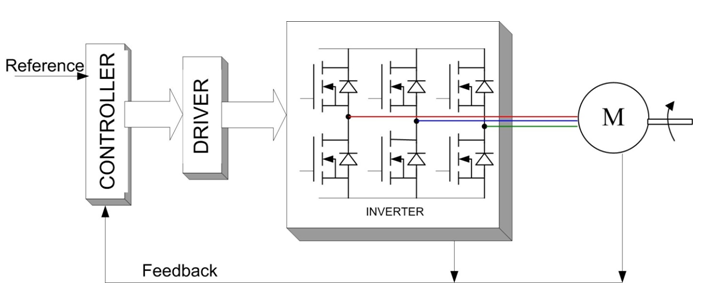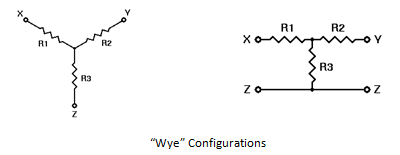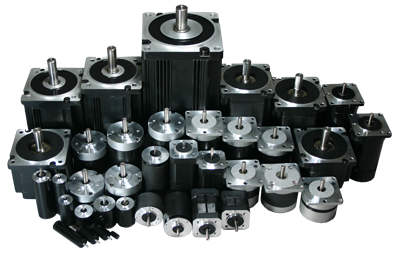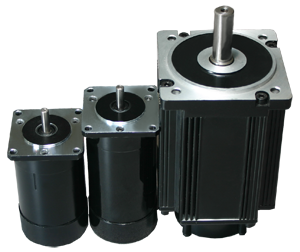What is a Brushless DC Motor?
A Brushless DC Motor
(also known as a BLDC Motor), is a synchronous electric motor powered
by a direct current. As the name implies, the Brushless DC Motor does
not operate using brushes; rather it operates with a controller via
electronic commutation.
Block Diagram for a Brushless DC Motor



How does a Brushless DC Motor Work?
A Brushless DC Motor is operated by
means of an electronic six-step commutation system. Unlike its Brush DC
Motor counterparts, the Brushless DC Motor does not contain any carbon
brushes. Instead, the electromagnets within the motor remain stationary
along with the armature, while the encased permanent magnets rotate,
generating torque. The Brushless DC Motor is synchronous; both the
stator and the magnetic field generate the same frequency, therefore
avoiding any type of “slip” most induction motors exhibit.
What is Six-Step Commutation?
Six-step commutation is a cost-effective
means of electronic commutation, due to the simple and relatively
inexpensive feedback and drive devices. In six-step commutation, only
two out of the three Brushless DC Motor windings are used at a time.
Steps are equivalent to 60 electrical degrees, so six steps makes a
full, 360 degree rotation. One full 360 degree loop is able to control
the current, due to the fact that there is only one current path.
Six-step commutation is typically useful in applications requiring high
speed and commutation frequencies. A six-step Brushless DC Motor usually
has lower torque efficiency than a sine-wave commutated motor.
How is a Brushless DC Motor Controlled?
An electronic Brushless DC Controller
(also known as a Driver, or Electronic Speed Controller), replaces the
mechanical commutation system utilized by a Brush DC Motor, and is
required by most Brushless DC Motors to operate. In a Brushless DC Motor
controller, either a Hall Effect Sensor or Back EMF (Electromotive
Force) is used to identify the position of the rotor. Understanding the
orientation of the rotor is crucial to operating the Brushless DC Motor.
The Hall Effect uses three hall sensors within the Brushless DC Motor to help detect the position of the rotor. This method is primarily used in speed detection, positioning, current sensing, and proximity switching. The magnetic field changes in response to the transducer that varies its output voltage. Feedback is created by directly returning a voltage, because the sensor operates as an analogue transducer. The distance between the Hall plate and a known magnetic field can be determined with a group of sensors, and the relative position of the magnet can be deduced. A Hall sensor can act as an on/off switch in a digital mode when combined with circuitry.
Back EMF, also known as the Counter-Electromotive Force, is caused by a changing electromagnetic field. In a Brushless DC Motor, back EMF is a voltage that occurs where there is motion between the external magnetic field and the armature of the motor. In other words, the voltage is developed in an inductor by an alternating or pulsating current. The polarity of the voltage is constantly the reverse of the input voltage. This method is commonly used to measure the position and speed of the Brushless DC Motor indirectly, and due to the lack of Hall Sensors within the controller, these are often referred to as sensorless controllers.
Optical Encoders can also be added to the Brushless DC Motor, allowing both direction and speed to be determined. More precise applications may use Optical Encoders with a third index signal, to determine pulse per revolution.
The Hall Effect uses three hall sensors within the Brushless DC Motor to help detect the position of the rotor. This method is primarily used in speed detection, positioning, current sensing, and proximity switching. The magnetic field changes in response to the transducer that varies its output voltage. Feedback is created by directly returning a voltage, because the sensor operates as an analogue transducer. The distance between the Hall plate and a known magnetic field can be determined with a group of sensors, and the relative position of the magnet can be deduced. A Hall sensor can act as an on/off switch in a digital mode when combined with circuitry.
Back EMF, also known as the Counter-Electromotive Force, is caused by a changing electromagnetic field. In a Brushless DC Motor, back EMF is a voltage that occurs where there is motion between the external magnetic field and the armature of the motor. In other words, the voltage is developed in an inductor by an alternating or pulsating current. The polarity of the voltage is constantly the reverse of the input voltage. This method is commonly used to measure the position and speed of the Brushless DC Motor indirectly, and due to the lack of Hall Sensors within the controller, these are often referred to as sensorless controllers.
Optical Encoders can also be added to the Brushless DC Motor, allowing both direction and speed to be determined. More precise applications may use Optical Encoders with a third index signal, to determine pulse per revolution.
The Brushless DC Motor consists of a
rotating rotor, Neodymium Iron Boron magnets, and a stator. Brushless DC
Motors are considered to be an “inside-out” version of a Brush DC
Motor; the commutator and brushes are nonexistent, and the windings are
located externally, connected to the controller. There are typically two
different construction types for the Brushless DC Motor: inrunner and
outrunner configurations. The inrunner configuration consists of three
stator windings located around the rotor, with permanent magnets as a
part of the rotor. The outrunner has a reversed relationship between the
magnets and the coils. The permanent magnets rotate inside a suspended
rotor surrounding the core of the Brushless DC Motor.
Internally, a 3-phase motor can be configured to a “Wye” or “Delta” configuration. The primary advantage to the “Wye” configuration, also known as the Star configuration, is that the phase-to-neutral voltage is equal in all three legs. The arrangement is a parallel circuit in a shape of the letter Y, where all windings are connected at a central point, and power is applied to the remaining windings.
Internally, a 3-phase motor can be configured to a “Wye” or “Delta” configuration. The primary advantage to the “Wye” configuration, also known as the Star configuration, is that the phase-to-neutral voltage is equal in all three legs. The arrangement is a parallel circuit in a shape of the letter Y, where all windings are connected at a central point, and power is applied to the remaining windings.

The Delta configuration creates a
triangle-like figure, making it a series circuit. This configuration
applies power to each of the connections.

How to Select a Brushless DC Motor
Selecting the appropriate Brushless DC Motor
requires knowing the requirements of the application, such as torque,
speed, size, power, length, etc. While determining which Brushless DC
Motor best fits the requirements, the controller must be considered as
well, as this goes hand in hand with the operation of the Brushless DC
Motor.
Lastly, environment is important to consider. Applications requiring a harsh, damp environment may require motors with specific IP ratings. For more detailed information on this subject, see Brushless DC Motor Environmental Considerations.
Lastly, environment is important to consider. Applications requiring a harsh, damp environment may require motors with specific IP ratings. For more detailed information on this subject, see Brushless DC Motor Environmental Considerations.
Brushless DC Motor Applications
The cost of the Brushless DC Motor has
declined since its introduction, due to advancements in materials and
design. This decrease in price, coupled with the many advantages it has
over the Brush DC Motor, makes the Brushless DC Motor a popular
component in many different applications. Applications that utilize the
Brushless DC Motor include, but are not limited to:

| • Instrumentation |
| • Medical |
| • Appliances |
| • Automotive |
| • Factory Automation Equipment |
| • Aerospace |
| • Military |
Advantages of a Brushless DC Motor
The absence of brushes in a Brushless DC Motor
is perhaps its greatest advantage. The carbon brushes within a Brush DC
Motor wear out rapidly and need replacing, which can be costly in the
long run. The Brushless DC Motor generates less noise, and is less prone
to sparking due to the lack of a commutator. The Brushless DC Motor is
typically smaller and lighter than the Brush DC Motor,
making it ideal for applications where weight and space are important
factors. The Brushless DC motor is cleaner, more powerful, and requires
lower maintenance than does the Brush DC Motor. It has higher speed
ranges, higher dynamic responses, and ultimately outlasts the Brush DC
Motor in total operating hours.
Disadvantages of a Brushless DC Motor
There are numerous applications using a Brush DC Motor
that could instead utilize the Brushless DC Motor. However a few
factors might prevent the changeover. The first factor is start-up cost.
Although the Brushless DC Motor is lower-maintenance than the Brush DC
Motor, initial cost is more expensive, due to its advantageous
construction. Second is complexity. A controller is required in order to
operate a Brushless DC Motor, and is usually more convoluted than most
controllers. A Brushless DC Motor also requires additional system
wiring, in order to power the electronic commutation circuitry.
Lifetime of a Brushless DC Motor
The Brushless DC Motor is often considered
superior over the Brush DC Motor for its substantially longer lifespan.
If run within the given specifications, the Brushless DC Motor can last
over 20,000 operating hours based on bearing life. Running a Brushless
DC Motor outside of its specifications shortens this lifespan.
Required Maintenance of a Brushless DC Motor
Due to the lack of brushes or a commutator,
there is nothing to replace within a Brushless DC Motor, making it
extremely low maintenance. The only requirement is that the motor be run
within proper specifications, and in a clean environment to ensure it
does not overheat or result in system failure.
Brushless DC Motor Environmental Considerations
 Precaution must be taken by the user with
respect to the environment of the Brushless DC Motor system during
operation, repair, and service. The environment in which a Brushless DC
Motor is used, must be conducive to good general practices of electrical
equipment. Do not run a Brushless DC Motor system near flammable gases,
dust, oil, vapor or moisture. The Brushless DC Motor must be protected
by a cover if operated outdoors, ensuring the motor receives adequate
air flow and cooling. Any presence of moisture may result in system
failure and/or electric shock. Therefore adequate care should be taken
to avoid any interaction between the Brushless DC Motor and any kind of
moisture or vapors. A Brushless DC Motor should be installed in an
environment free from vibration, shock, condensation, dust and
electrical noise.
Precaution must be taken by the user with
respect to the environment of the Brushless DC Motor system during
operation, repair, and service. The environment in which a Brushless DC
Motor is used, must be conducive to good general practices of electrical
equipment. Do not run a Brushless DC Motor system near flammable gases,
dust, oil, vapor or moisture. The Brushless DC Motor must be protected
by a cover if operated outdoors, ensuring the motor receives adequate
air flow and cooling. Any presence of moisture may result in system
failure and/or electric shock. Therefore adequate care should be taken
to avoid any interaction between the Brushless DC Motor and any kind of
moisture or vapors. A Brushless DC Motor should be installed in an
environment free from vibration, shock, condensation, dust and
electrical noise.
Formulas
What is the Kt Constant in a Brushless DC Motor?
Winding Power = Kt*Kt/R
Kv = 1000 rpm / Vrms
Kt = oz-in / Amp
Kt = Kb * 1.35
Ke = Vrms / 1000 rpm
Kb = V / 1000 rpm
Back EMF = V/KRPM
Kv = 1000 rpm / Vrms
Kt = oz-in / Amp
Kt = Kb * 1.35
Ke = Vrms / 1000 rpm
Kb = V / 1000 rpm
Back EMF = V/KRPM